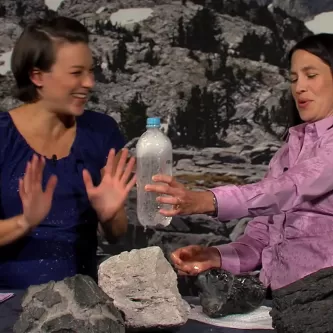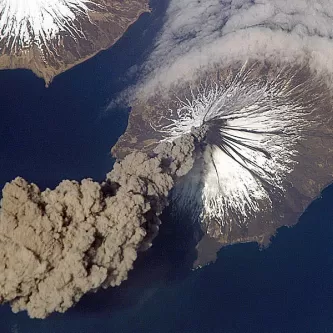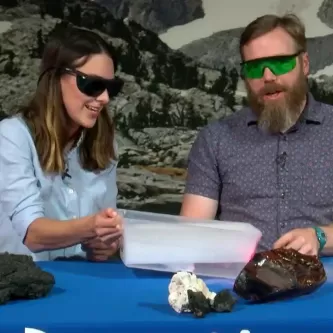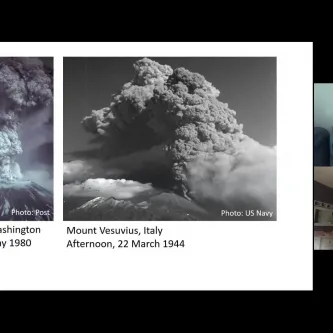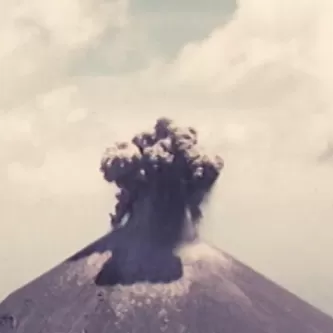Search
When Volcanoes Erupt
Volcanoes Have Various Impacts
Erupting volcanoes are powerful forces of nature that both build and destroy. For example, undersea volcanic eruptions created the Hawaiian Islands, and to this day the Hawaiian volcano Kilauea oozes lava into the sea, creating new coastland on the southeastern side of the Big Island of Hawaii. On the southeast slope of the Big Island is a growing submarine volcano called Loihi, which will not breach the ocean’s surface for tens of thousands of years.
Kilauea has been continuously erupting since 1983, often emitting lava flows. In contrast, other types of volcanoes erupt quickly and violently, in huge explosions that can send up large columns of gas and ash, rain down rocks, spew lava, and unleash pyroclastic flows – large masses of hot rock fragments and gas that speed down a volcano’s slopes. These eruptions can destroy lives and property. In the continental United States, the most recent and deadly volcanic eruption came on May 18, 1980, when Mt. St. Helens blew its top–and one whole side of the mountain–killing 60 people and leveling 600 square kilometers (232 sq. miles) of forest.
The most powerful volcanic eruption observed in recent history was in 1815 at the Tambora volcano in Indonesia, which produced huge pyroclastic flows and ejected large quantities of fine ash and gases into the stratosphere. The eruption killed an estimated 60,000 people and the resulting volcanic cloud lowered temperatures around the globe by as much as 3 degrees Celsius (5.4 degrees Fahrenheit). In parts of Europe and North America, 1816 was known as the “year without a summer,” due to the cooler temperatures.
The Science of Volcanoes
Volcanic eruptions are vivid reminders that our planet is a geologically active and dynamic place. On any given day, scientists estimate 20 volcanoes worldwide are erupting on the land. Still more are probably erupting underwater, but scientists don't have enough instruments to detect them. Many of these submarine eruptions theoretically occur along mid-ocean ridges, where an estimated 80 percent of Earth's magma erupts unnoticed.
An erupting volcano is like a window into the depths of the Earth, because lava and other erupted material provide clues to the mystery of what is going on far below the surface. For example, scientists can use these materials to learn about the composition, temperature and history of Earth’s interior.
To help understand the components of Earth’s interior, Smithsonian volcanologist Dr. Elizabeth Cottrell simulates the conditions deep under volcanoes by using special machines to generate the immense pressure found many kilometers under the Earth’s surface. The machine compresses and melts rock samples, essentially recreating the magma from which the rock sample came. She uses her findings to understand how the interior of the planet has evolved over many millions of years.
Dr. Benjamin Andrews, another Smithsonian volcanologist, performs similar experiments on erupted volcanic rocks in order to understand the geological conditions deep underground that preceded the eruptions. This information can help scientists better predict future eruptions.
Volcanoes of different ages can provide insight into scientific fields beyond geology. Smithsonian scientist Dr. Helen James explores lava tubes and other volcanic caves, searching for fossils of extinct animals, mainly birds. She conducts most of her research in the Hawaiian Islands, which were formed one at a time over millions of years, as the Pacific Plate moved over the Hawaiian hotspot, with the youngest island to the southeast, and oldest to the northwest. This makes the islands a great place to study the evolution of biodiversity over time.
The Hawaiian Islands were created by volcanoes and Hawaiians believe the volcano goddess Pele lives in Kilauea volcano. A traditional epic story about Pele and her sister Hi'iaka is a main source of Hawaiian poetry, music and dance. Smithsonian anthropologist Dr. Adrienne Kaeppler studied Hawaiian hula dance and how it relates to, and honors, Pele.
Forecasting Volcanic Eruptions
Volcanoes and humans have an uneasy coexistence, because volcanic eruptions can cause severe destruction. More than three dozen historical eruptions have each caused more than 1,000 fatalities. Yet they provide myriad benefits as well: Volcanic soils are very fertile for agriculture, for example, and support habitats for wildlife. Also, many ore deposits, from gold to diamonds, are closely associated with volcanoes.
Scientists use a wide variety of techniques to monitor volcanoes, including seismology (detection of the earthquakes and tremors that almost always precede eruptions), precise measurements of ground deformation (such as bulges) that often accompanies the rise of magma, changes in volcanic gas emissions, and changes in gravity and magnetic fields. These techniques, when used in combination at well-monitored volcanoes, have resulted in successful predictions. At Pinatubo volcano (Philippines) in 1991, a successful forecast saved thousands of lives.
Monitoring-based forecasts are becoming much more reliable, but they remain imperfect. If scientists are fortunate, precursors to an eruption follow the same course as seen and recognized before previous eruptions. Patterns often change, however, and wholly new behavior is observed. The best forecasts will be based on an integration of geologic history, real-time monitoring, and a deep understanding of the internal plumbing processes of the specific volcano. Even with the best of monitoring and interpretations, reliable forecasts are rarely possible more than a few days in advance of an eruption.
The Smithsonian Institution’s Global Volcanism Program is devoted to a better understanding of the Earth’s 1,600 known active volcanoes and their eruptions during the last 10,000 years. The program documents both current and past volcanic activity; its website contains more than 7,000 activity reports.

